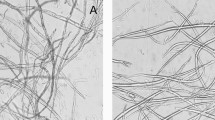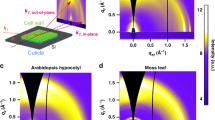Abstract
ROTATORY dispersion studies have been conducted on a large number of proteins and polypeptides1-3. We wish to report some preliminary studies on the rotatory dispersion of polysaccharides. The material used for this work was ‘Methocel’ (registered trade mark of the Dow Chemical Company, Midland, Michigan) supplied by the Dow Chemical Co. ‘Methocel’ is a partially methylated cellulose which has the characteristic of being more soluble in cold water than in hot water. This investigation was carried out on material with an intrinsic viscosity of 1.6 (corresponding roughly to a molecular weight of 35,000) and a methyoxyl analysis of 29.5 per cent (1.8 OCH3 groups/anhydroglucose unit). The method of solubilizing this particular polysaccharide consisted in dispersing the material in boiling water and allowing it to cool to room termperature. Solution A (Figs. 1 and 2) was further cooled to 0° C. overnight and then maintained at room temperature (24° C.). Solution D (Figs. 1 and 2) was maintained at room temperature. The dispersion curves for these two solutions are shown in Fig. 1. The majority of the measurements were carried out on a Keston photoelectric polarimeter attached to the Beckman DU spectrophotometer. The cell was covered with black paper to eliminate any spurious rotation as described in a recent paper by Winkler and Markus4. The dispersion curve of solution A from 270 mµ to 600 mµ was obtained on a Rudolph photoelectric spectropolarimeter, model 200 S. (The use of this instrument was kindly permitted by Prof. M. L. Wolfrom of the Chemistry Department, Ohio State University, Columbus, Ohio.) The results using the Keston instrument checked very well with the results on the Rudolph instrument.
This is a preview of subscription content, access via your institution
Access options
Subscribe to this journal
Receive 51 print issues and online access
$199.00 per year
only $3.90 per issue
Buy this article
- Purchase on Springer Link
- Instant access to full article PDF
Prices may be subject to local taxes which are calculated during checkout
Similar content being viewed by others
References
Doty, P., and Yang, J. T., J. Amer. Chem. Soc., 78, 498 (1956).
Yang, J. T., and Doty, P., J. Amer. Chem. Soc., 79, 761 (1957).
Jirgensons, B., Arch. Biochem. Biophys., 74, 57, 70 (1958); 78, 227, 235 (1958).
Winkler, M. H., and Markus, G., J. Amer. Chem. Soc., 81, 1873 (1959).
Author information
Authors and Affiliations
Rights and permissions
About this article
Cite this article
NEELY, W. Optical Rotatory Dispersion Studies on Partially Methylated Cellulose. Nature 185, 159–160 (1960). https://doi.org/10.1038/185159b0
Issue Date:
DOI: https://doi.org/10.1038/185159b0
Comments
By submitting a comment you agree to abide by our Terms and Community Guidelines. If you find something abusive or that does not comply with our terms or guidelines please flag it as inappropriate.



